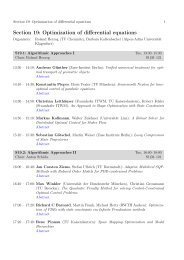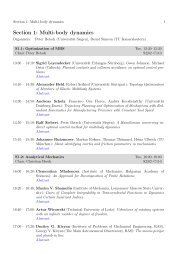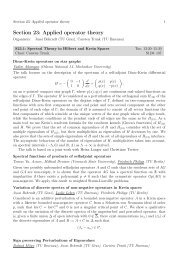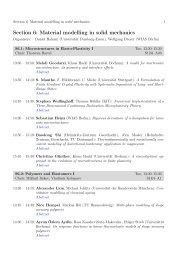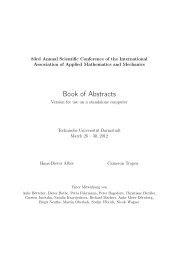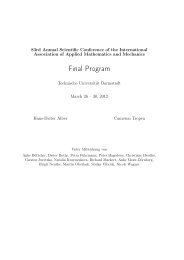Section 6: Material modelling in solid mechanics - GAMM 2012
Section 6: Material modelling in solid mechanics - GAMM 2012
Section 6: Material modelling in solid mechanics - GAMM 2012
You also want an ePaper? Increase the reach of your titles
YUMPU automatically turns print PDFs into web optimized ePapers that Google loves.
30 <strong>Section</strong> 6: <strong>Material</strong> <strong>modell<strong>in</strong>g</strong> <strong>in</strong> <strong>solid</strong> <strong>mechanics</strong><br />
idealized phenomena (e.g. nonl<strong>in</strong>ear elastic behaviour and viscous or plastic yield<strong>in</strong>g). Several<br />
of those elements are then assembled to one complex material model. This can be achieved by<br />
enforc<strong>in</strong>g the equilibrium of stresses on the connect<strong>in</strong>g po<strong>in</strong>ts between rheological elements.<br />
With<strong>in</strong> the scope of nonl<strong>in</strong>ear cont<strong>in</strong>uum <strong>mechanics</strong> there also exists the concept of rheological<br />
elements. The k<strong>in</strong>ematics is described by the deformation gradient which gets multiplicatively<br />
decomposed <strong>in</strong>to several sub deformation gradients. For the def<strong>in</strong>ition of the material behaviour,<br />
a common approach is to formulate a free energy function as a sum of sub free energy functions<br />
attributed to the def<strong>in</strong>ed sub deformation gradients. By the evaluation of the Clausius-Duhem<strong>in</strong>equality<br />
and under consideration of constitutive assumptions a system of equations describ<strong>in</strong>g<br />
a thermodynamically consistent material behaviour can be derived. Depend<strong>in</strong>g on particular def<strong>in</strong>itions,<br />
those materials can <strong>in</strong>clude a mixture of elastic, viscous and plastic material behaviour.<br />
An alternative approach has been presented by Ihlemann (2006). It is based on the additive<br />
decomposition of the stress power density and leads to a system of equations for the derivation<br />
of the stress equilibrium on def<strong>in</strong>ed <strong>in</strong>termediate configurations as well as the derivation of the<br />
total stresses. Special attention has to be given to the def<strong>in</strong>ition of accurate stress measures on<br />
the <strong>in</strong>termediate configurations. By this approach, a formal procedure for the direct connection of<br />
s<strong>in</strong>gle elements at large deformation processes can be obta<strong>in</strong>ed. The procedure itself is <strong>in</strong>dependent<br />
of the concrete material behaviour.<br />
The concept of direct connection of rheological elements <strong>in</strong> nonl<strong>in</strong>ear cont<strong>in</strong>uum <strong>mechanics</strong><br />
and some examples for its application will be presented. Furthermore, a numerical strategy for<br />
the direct implementation of this concept will be demonstrated.<br />
[1] J. Ihlemann (2006), Beobachterkonzepte und Darstellungsformen der nichtl<strong>in</strong>earen Kont<strong>in</strong>uumsmechanik,<br />
Habilitation, Universität Hannover<br />
A stochastic model for the direct and the <strong>in</strong>verse problem of adhesive materials<br />
N. Nörenberg, R. Mahnken (Universität Paderborn)<br />
This work deals with the generation of artificial data [1] based on experimental data for adhesive<br />
materials and the application of this data to the <strong>in</strong>verse and the direct problem. In reality there are<br />
only a very limited number of experimental data available. Therefore, the prediction of material<br />
behaviour is difficult and a statistical analysis with a stochastic proved thesis is nearly impossible.<br />
In order to <strong>in</strong>crease the number of tests a method of stochastic simulation based on time series<br />
analysis [2] is applied. With artificial data an arbitrary number of data is available and the<br />
process of the parameter identification can be statistically analysed. Additionally, two examples<br />
are shown, which adapt the analysed material parameter to the direct problem. The stochastic<br />
f<strong>in</strong>ite element method [3] is used to take <strong>in</strong>to account the distribution and deviation of the fracture<br />
stra<strong>in</strong>.<br />
[1] S. Schwan, Identifikation der Parameter <strong>in</strong>elastischer Werkstoffmodelle: Statistische Analyse<br />
und Versuchsplanung. Diss. Shaker, 2000.<br />
[2] P. J. Brockwell and R. A. Davis, Time series: theory and methods. Spr<strong>in</strong>ger, 2009<br />
[3] I. Babuška, R. Tempone and G. E. Zouraris, Galerk<strong>in</strong> f<strong>in</strong>ite element approximations of stochastic<br />
elliptic partial differential equations. SIAM Journal on Numerical Analysis 42(2)<br />
(2005), 800 – 825



